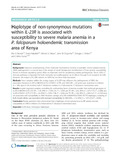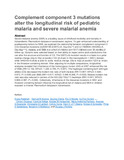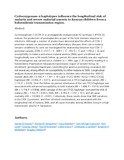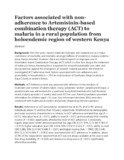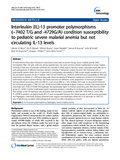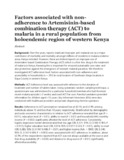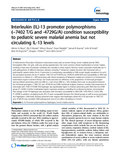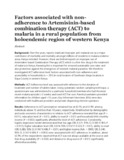Search
Now showing items 1-9 of 9
Interleukin (IL)-13 promoter polymorphisms (-7402 T/G and -4729G/A) condition susceptibility to pediatric severe malarial anemia but not circulating IL-13 levels
(BMC Immunology, 2013-03-25)
In holoendemic Plasmodium falciparum transmission areas such as western Kenya, severe malarial anemia [SMA, hemoglobin (Hb) < 6.0 g/dL, with any density parasitemia] is the most common clinical manifestation of severe ...
Complement component 3 mutations alter the longitudinal risk of pediatric malaria and severe malarial anemia
(Experimental Biology and Medicine, 2021-11-19)
Severe malarial anemia (SMA) is a leading cause of childhood morbidity and mortality in holoendemic Plasmodium falciparum transmission regions. To gain enhanced understanding of predisposing factors for SMA, we explored ...
Cyclooxygenase-2 haplotypes influence the longitudinal risk of malaria and severe malarial anemia in Kenyan children from a holoendemic transmission region.
(Journal of Human Genetics, 2019-10-29)
Cyclooxygenase-2 [(COX-2) or prostaglandin endoperoxide H2 synthase-2 (PTGS-2)] induces the production of prostaglandins as part of the host-immune response to infections. Although a number of studies have demonstrated the ...
Factors associated with non-adherence to Artemisinin-based combination therapy (ACT) to malaria in a rural population from holoendemic region of western Kenya
(National Library of Medicine, 2012-06-24)
Background: Over the years, reports implicate improper anti-malarial use as a major contributor of morbidity and mortality amongst millions of residents in malaria endemic areas, Kenya included. However, there are limited ...
Interleukin (IL)-13 promoter polymorphisms (-7402 T/G and -4729G/A) condition susceptibility to pediatric severe malarial anemia but not circulating IL-13 levels
(BMC Imunology, 2013-03-25)
n holoendemic Plasmodium falciparum transmission areas such as western Kenya, severe malarial anemia [SMA, hemoglobin (Hb) < 6.0 g/dL, with any density parasitemia] is the most common clinical manifestation of severe malaria ...
Factors associated with non-adherence to Artemisinin-based combination therapy (ACT) to malaria in a rural population from holoendemic region of western Kenya
(National Library of Medicine, 2012-06-24)
Background: Over the years, reports implicate improper anti-malarial use as a major contributor of morbidity and mortality amongst millions of residents in malaria endemic areas, Kenya included. However, there are limited ...
Interleukin (IL)-13 promoter polymorphisms (-7402 T/G and -4729G/A) condition susceptibility to pediatric severe malarial anemia but not circulating IL-13 levels.
(BMC Immunology, 2013-03-13)
In holoendemic Plasmodium falciparum transmission areas such as western Kenya, severe malarial anemia [SMA, hemoglobin (Hb) < 6.0 g/dL, with any density parasitemia] is the most common clinical manifestation of severe ...
Factors associated with non-adherence to Artemisinin-based combination therapy (ACT) to malaria in a rural population from holoendemic region of western Kenya
(National Library of Medicine, 2012-06-24)
Background: Over the years, reports implicate improper anti-malarial use as a major contributor of morbidity and mortality amongst millions of residents in malaria endemic areas, Kenya included. However, there are limited ...
Transcriptomic and Proteomic Insights into Host Immune Responses in Pediatric Severe Malarial Anemia: Dysregulation in HSP60-70-TLR2/4 Signaling and Altered Glutamine Metabolism
(Pathogens, 2024-09-03)
Severe malarial anemia (SMA, Hb < 6.0 g/dL) is a leading cause of childhood morbidity and mortality in holoendemic Plasmodium falciparum transmission zones. This study explored the entire expressed human transcriptome in ...

